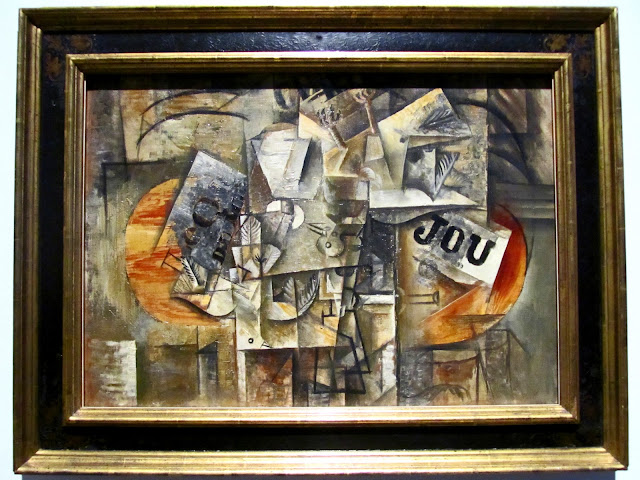I took this picture while sitting on the front steps of the NYU building on Segre. I decided to kill time between orientation classes and our trip to the museum by sitting out here, absorbing the sun, and reading from my Kindle.
Last day with Profesora Prieto and Profesor Kavanagh! We concluded our "tres mil años en tres días" with ¨Contemporary Spain: The Long Road to Modernization." I am already missing Profesor Kavanagh and completely sure that my actual professors this semester will never live up to him.
But anyway, on to pictures of our trip to the museum!
The front of the Museo de la Reina Sofía opens onto this small square and, thanks to all the signs, was very easy to find. (For that reason alone, I love the touristy parts of town.) The other entrance was a bit more difficult, though, and that's where we were supposed to meet. What you see here is part of the old museum, and when I say "old," I mean very old. It was originally the General Hospital, constructed from 1756 to 1781 by order of King Felipe II. The design is very simple: four halls on every floor, forming a square around a central courtyard. Here you are looking at the outside of just one part of the square.
Once you wander around the building in search of that other mysterious entrance, though, you see it is no longer just one little square building. An incredibly modern, incredibly large addition has been added, forming a kind of over-sized, outdoor lobby.
To give you a point of reference to imagine this, keep in mind that the stairs in the last picture were both quite far behind me and quite far to the left when I took this one.
The statue was made by American artist Roy Lichtenstein as part of a series called "Las pinceladadas." This particular piece is just a single one of these"brushstrokes."
I took this while still standing in the same place relative to the statue, pivoting slightly to right. The glass wall is part of the library, apparently one of the most extensive in Madrid.
Here's a better look at the library from a vantage point directly to the side of the statue.
And finally, inside the museum itself! We passed through the modern section very quickly and I kept getting told off whenever I brought out my camera there, so this was my first photo opportunity after entering. (It's also worth noting that none of the museums in Madrid permit you to wear backpacks. You have to pay a euro to store it in a locker by the entrance. I ended up holding up the group a bit while trying to figure out what change the locker would take.) Anyway, this is one of the four identical halls of this floor in the old part of the building. The windows to the right (hidden by the columns) look out on the central courtyard.
I could not stop staring at this, partly because the title of the work is "Retrato de Sonia de Klamery, Candesa de Pradére," indicating that the woman shown is a Countess! I just could not reconcile her pose with her title. It was painted in 1913. I still can't imagine that commissioning paintings like this was very Countess-like behavior then.
This is a photo taken by José Ortiz-Echagüe that was then specially treated to look more like a painting, although I'm not really sure that effect comes through very well in my photograph of the photo. It's called "Lagarteranas en misa," "Women of Lagartera at Mass" and was taken in 1925.
I think I just thought this one was cool. I loved the colors and perfect neatness of it... not to mention that gorgeous frame. :)
See, this is the kind of painting that makes me think that Picasso wasn't all that impressive. From some of his other works, I know he had the ability to make beautiful or even just extraordinarily interesting pieces. But this... This just doesn't interest me. I'm slightly more interested when I hear that the actual woman may well have been a prostitute hired off the street to dress up like this and pose. But then after a moment or two of consideration, I'm bored again.
Now THIS is an example of one of Picasso's more fascinating works. He made this in 1912. Originally exhibited in France, it was called "Les oiseaux morts" - "Dead Birds."
This was painted by Picasso two years before "Dead Birds." It's called "Le compotier" - "Fruit Bowl." Maybe he was just practicing for the later piece?
This is "Paysage avec moulin" by Albert Gleizes. Not a huge fan of the really abstract, and I definitely don't see the "Landscape with Mill" here, but I appreciate the brilliancy of the colors and can see where a lot of thought and planning went into it.
"Portrait de madamme Josette Gris," an oil on canvas painted in 1916 by Juan Gris.
I thought this was cool but was pulled away by my group before I could read a description of it, so I have no idea how old it is, who made it, or what it's called.
This struck me as in interesting piece all around. It's by José Renau and was put together in 1937. A translation of the text is as follows:
Shedding her Outer Layer of Superstition and Misery, from the Immemorial Slave there Emerged THE WOMAN Capable of Active Participation in the Making of the Future.




















No comments:
Post a Comment